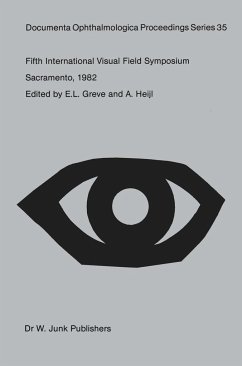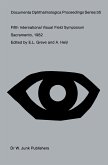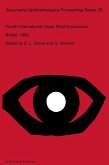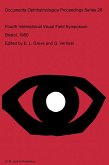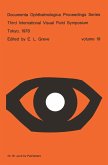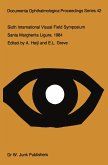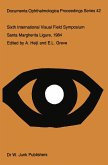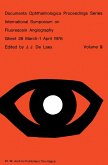E.L. Greve / A. Heijl (eds.)Sacramento, October 20-23, 1982
Fifth International Visual Field Symposium
Sacramento, October 20-23, 1982
Herausgegeben:Greve, E. L.; Heijl, A.
E.L. Greve / A. Heijl (eds.)Sacramento, October 20-23, 1982
Fifth International Visual Field Symposium
Sacramento, October 20-23, 1982
Herausgegeben:Greve, E. L.; Heijl, A.
- Gebundenes Buch
- Merkliste
- Auf die Merkliste
- Bewerten Bewerten
- Teilen
- Produkt teilen
- Produkterinnerung
- Produkterinnerung
The 5th International Visual Field Symposium of the International Peri metric Society was held on October 20-23, 1982, in Sacramento, California, before the joint meeting of the International Congress of Ophthalmology and the American Academy of Ophthalmology. A majority of the members of the International Perimetric Society took part in the meeting together with many guests. The topics of the symposium were: glaucoma: correlation between the visual field and the optic disc; the visual field in low-tension glaucoma; neuro-ophthalmology and ergo-perimetry. Apart from this there were many…mehr
Andere Kunden interessierten sich auch für
![Fifth International Visual Field Symposium Fifth International Visual Field Symposium]() Fifth International Visual Field Symposium42,99 €
Fifth International Visual Field Symposium42,99 €![Fourth International Visual Field Symposium Bristol, April 13-16,1980 Fourth International Visual Field Symposium Bristol, April 13-16,1980]() Fourth International Visual Field Symposium Bristol, April 13-16,1980112,99 €
Fourth International Visual Field Symposium Bristol, April 13-16,1980112,99 €![Fourth International Visual Field Symposium Bristol, April 13¿16,1980 Fourth International Visual Field Symposium Bristol, April 13¿16,1980]() Fourth International Visual Field Symposium Bristol, April 13¿16,198042,99 €
Fourth International Visual Field Symposium Bristol, April 13¿16,198042,99 €![Third International Visual Field Symposium Tokyo, May 3¿6, 1978 Third International Visual Field Symposium Tokyo, May 3¿6, 1978]() E. L. GreveThird International Visual Field Symposium Tokyo, May 3¿6, 197842,99 €
E. L. GreveThird International Visual Field Symposium Tokyo, May 3¿6, 197842,99 €![Sixth International Visual Field Symposium Sixth International Visual Field Symposium]() A. Heijl / E.L. Greve (eds.)Sixth International Visual Field Symposium112,99 €
A. Heijl / E.L. Greve (eds.)Sixth International Visual Field Symposium112,99 €![Sixth International Visual Field Symposium Sixth International Visual Field Symposium]() Sixth International Visual Field Symposium42,99 €
Sixth International Visual Field Symposium42,99 €![International Symposium on Fluorescein Angiography Ghent 28 March-1 April 1976 International Symposium on Fluorescein Angiography Ghent 28 March-1 April 1976]() International Symposium on Fluorescein Angiography Ghent 28 March-1 April 197643,99 €
International Symposium on Fluorescein Angiography Ghent 28 March-1 April 197643,99 €-
-
-
The 5th International Visual Field Symposium of the International Peri metric Society was held on October 20-23, 1982, in Sacramento, California, before the joint meeting of the International Congress of Ophthalmology and the American Academy of Ophthalmology. A majority of the members of the International Perimetric Society took part in the meeting together with many guests. The topics of the symposium were: glaucoma: correlation between the visual field and the optic disc; the visual field in low-tension glaucoma; neuro-ophthalmology and ergo-perimetry. Apart from this there were many papers on automated perimetry and general topics. The papers concerning the correlation of optic disc and visual field dealt with several aspects: peripapillary atrophy, defects in the retinal nerve fiber layer, fluorescein angiography and the characteristics of the glaucomatous excavation itself. New and interesting findings were presented showing that the careful, detailed observation of the disc and peripapillary area is re warding. The visual fields in low-tension glaucoma were studied extensively by four groups. Various approaches to the problem have led to some differences in results, which were extensively discussed. In the general glaucoma session the visual fatigue phenomenon was dis cussed extensively; apparently conflicting results were demonstrated re garding the stability of contrast threshold measurements during one and the same test session in glaucoma. The relationship between the visual field and the performance at the working place was considered in the session on ergo-perimetry.
Hinweis: Dieser Artikel kann nur an eine deutsche Lieferadresse ausgeliefert werden.
Hinweis: Dieser Artikel kann nur an eine deutsche Lieferadresse ausgeliefert werden.
Produktdetails
- Produktdetails
- Documenta Ophthalmologica Proceedings Series 35
- Verlag: Springer / Springer Netherlands
- Artikelnr. des Verlages: 978-90-6193-731-9
- 1983.
- Seitenzahl: 516
- Erscheinungstermin: 31. Oktober 1983
- Englisch
- Gewicht: 1080g
- ISBN-13: 9789061937319
- ISBN-10: 9061937310
- Artikelnr.: 26629944
- Herstellerkennzeichnung
- Libri GmbH
- Europaallee 1
- 36244 Bad Hersfeld
- gpsr@libri.de
- Documenta Ophthalmologica Proceedings Series 35
- Verlag: Springer / Springer Netherlands
- Artikelnr. des Verlages: 978-90-6193-731-9
- 1983.
- Seitenzahl: 516
- Erscheinungstermin: 31. Oktober 1983
- Englisch
- Gewicht: 1080g
- ISBN-13: 9789061937319
- ISBN-10: 9061937310
- Artikelnr.: 26629944
- Herstellerkennzeichnung
- Libri GmbH
- Europaallee 1
- 36244 Bad Hersfeld
- gpsr@libri.de
Glaucoma: Correlation of disc, retinal nerve fiber layer and visual field.- Correlation of the peripapillary anatomy with the disc damage and field abnormalities in glaucoma.- The first observable glaucoma changes after an optic disc haemorrhage.- Correlation between computerized perimetry and retinal nerve fibre layer photography after optic disc haemorrhage.- Kinetic quantitative perimetry of retinal nerve fiber layer defects in glaucoma by fundus photo-perimeter.- The relation between excavation and visual field in glaucoma patients with high and with low intraocular pressures.- Computer-generated display for three-dimensional static perimetry: correlation of optic disc changes with glaucomatous defects.- Correlation between the stereographic shape of the ocular fundus and the visual field in glaucomatous eyes.- The relationship between a circumlinear vessel gap at the neuroretinal rim and glaucomatous visual field loss.- Fluorescein angiographic defects of the optic disc in glaucomatous visual field loss.- Capillary hyperpermeability of the optic disc and functional evolution in glaucoma.- Optic disc changes with the progression of glaucomatous visual field damage.- Optic disc analysis by computerized image subtraction and perimetry.- Discussions.- Glaucoma: Visual field and low-tension glaucoma.- A comparative study of visual fields of patients with low-tension glaucoma and those with chronic simple glaucoma.- Comparison of glaucomatous visual field defects in patients with high and with low intraocular pressures.- The visual field defects of low-tension glaucoma (A comparison of the visual field defects in low-tension glaucoma with chronic open angle glaucoma).- Visual fields in low-tension glaucoma, primary open angle glaucoma, and anterior ischemic optic neuropathy.- Discussions.- Glaucoma: General.- Deterioration of threshold in glaucoma patients during perimetry.- Constancy of sensitivity in time in patients with open angle glaucoma: Further results.- Discussion.- The effect of a number of glaucoma medications on the differential light threshold.- Time resolution in glaucomatous visual field defects.- The location of earliest glaucomatous visual field defects documented by automatic perimetry.- The course of early visual field change in glaucoma as examined by pupillographic perimetry.- Ergo-perimetry.- The occupational visual field. I. Theoretical aspects: the normal functional visual field.- Functional scoring of the binocular visual field.- The representation of the visual field.- Investigations on space behaviour of glaucomatous people with extensive visual field loss.- Correlations between peripheral visual function and driving performance.- Non-linear projection in visual field charting.- Discussion.- Neuro-ophthalmology.- Methodological aspects of contrast sensitivity measurements in the diagnosis of optic neuropathy and maculopathy.- Visual fields versus visual evoked potentials in optic nerve disorders.- Homonymous quadrantanopia in a case of multiple sclerosis (Pupillographic, perimetric and VEP findings).- Hippocrates and homonymous hemianopsia.- Carotid perfusion and field loss.- Anterior ischemic optic neuropathy and associated visual field changes.- Computer-assisted perimetry results in neuro-ophthalmology problem cases.- Properties of scotomata in glaucoma and optic nerve disease: computer analysis.- Statistical analysis of normal visual fields and hemianopsias recorded by a computerized perimeter.- Visual fields in the management of unexplained visual loss: A cost-benefit analysis.- Quantitative isopter constriction under image degradation by defocus.- Visual field defect in thalamic hemorrhage.- Discussions.- Automated perimetry.- Clinical experiences with a new automated perimeter 'Peritest'.- Some possibilities of the Peritest automatic and semi-automatic perimeter.- New programs of the Scoperimeter.- Automated perimetry in aviation medicine (Visual field examination in 2500 flying personnel).- Angioscotoma: preliminary results using the new spatially adaptive program SAPRO.- The accuracy of screening programs.- Special Octopus software for clinical investigation.- Discussion.- Optimization of computer-assisted perimetry.- Automation of the Goldmann perimeter.- Preliminary examination of the Squid automated perimeter.- An evaluation of the Baylor semi-automated device.- The estimation and testing of the components of long-term fluctuation of the differential light threshold.- General topics.- Lateral inhibition in the fovea and parafoveal regions.- Extrafoveal Stiles' ? mechanisms.- Loss of inhibitory mechanisms as a measure of cone impairment: A method applied in static colour perimetry.- Perimetric techniques used to assess retinal strain during accommodation.- Static fundus perimetry in amblyopia: Comparison with juvenile macular degeneration.- The visual field in alternating hyperphoria.- Temporal resolution in the peripheral visual field.- Temporal resolution and stimulus intensity in the central visual field.- Diabetic retinopathy: Perimetric findings.- Static perimetry in central serous retinochoroidopathy (Masuda's type) using a fundus photo-perimeter.- Boundary curves for dividing visual fields into sectors corresponding to a retinotopic projection onto the optic disc.- The role of perimetry in retinal detachment.- Computer analysis of kinetic fielddata determined with a Goldmann perimeter.- Perimetric changes caused by ethyl alcohol.- Leukocytoclastic vasculitis associated with bilateral central field loss; improvement on corticosteroids and mercaptopurine.- Three-dimensional display of static perimetry.- The relationship between visual acuity, pupillary defect and visual field loss.- Ophthalmoscopic perimetry.- Discussions.
Glaucoma: Correlation of disc, retinal nerve fiber layer and visual field.- Correlation of the peripapillary anatomy with the disc damage and field abnormalities in glaucoma.- The first observable glaucoma changes after an optic disc haemorrhage.- Correlation between computerized perimetry and retinal nerve fibre layer photography after optic disc haemorrhage.- Kinetic quantitative perimetry of retinal nerve fiber layer defects in glaucoma by fundus photo-perimeter.- The relation between excavation and visual field in glaucoma patients with high and with low intraocular pressures.- Computer-generated display for three-dimensional static perimetry: correlation of optic disc changes with glaucomatous defects.- Correlation between the stereographic shape of the ocular fundus and the visual field in glaucomatous eyes.- The relationship between a circumlinear vessel gap at the neuroretinal rim and glaucomatous visual field loss.- Fluorescein angiographic defects of the optic disc in glaucomatous visual field loss.- Capillary hyperpermeability of the optic disc and functional evolution in glaucoma.- Optic disc changes with the progression of glaucomatous visual field damage.- Optic disc analysis by computerized image subtraction and perimetry.- Discussions.- Glaucoma: Visual field and low-tension glaucoma.- A comparative study of visual fields of patients with low-tension glaucoma and those with chronic simple glaucoma.- Comparison of glaucomatous visual field defects in patients with high and with low intraocular pressures.- The visual field defects of low-tension glaucoma (A comparison of the visual field defects in low-tension glaucoma with chronic open angle glaucoma).- Visual fields in low-tension glaucoma, primary open angle glaucoma, and anterior ischemic optic neuropathy.- Discussions.- Glaucoma: General.- Deterioration of threshold in glaucoma patients during perimetry.- Constancy of sensitivity in time in patients with open angle glaucoma: Further results.- Discussion.- The effect of a number of glaucoma medications on the differential light threshold.- Time resolution in glaucomatous visual field defects.- The location of earliest glaucomatous visual field defects documented by automatic perimetry.- The course of early visual field change in glaucoma as examined by pupillographic perimetry.- Ergo-perimetry.- The occupational visual field. I. Theoretical aspects: the normal functional visual field.- Functional scoring of the binocular visual field.- The representation of the visual field.- Investigations on space behaviour of glaucomatous people with extensive visual field loss.- Correlations between peripheral visual function and driving performance.- Non-linear projection in visual field charting.- Discussion.- Neuro-ophthalmology.- Methodological aspects of contrast sensitivity measurements in the diagnosis of optic neuropathy and maculopathy.- Visual fields versus visual evoked potentials in optic nerve disorders.- Homonymous quadrantanopia in a case of multiple sclerosis (Pupillographic, perimetric and VEP findings).- Hippocrates and homonymous hemianopsia.- Carotid perfusion and field loss.- Anterior ischemic optic neuropathy and associated visual field changes.- Computer-assisted perimetry results in neuro-ophthalmology problem cases.- Properties of scotomata in glaucoma and optic nerve disease: computer analysis.- Statistical analysis of normal visual fields and hemianopsias recorded by a computerized perimeter.- Visual fields in the management of unexplained visual loss: A cost-benefit analysis.- Quantitative isopter constriction under image degradation by defocus.- Visual field defect in thalamic hemorrhage.- Discussions.- Automated perimetry.- Clinical experiences with a new automated perimeter 'Peritest'.- Some possibilities of the Peritest automatic and semi-automatic perimeter.- New programs of the Scoperimeter.- Automated perimetry in aviation medicine (Visual field examination in 2500 flying personnel).- Angioscotoma: preliminary results using the new spatially adaptive program SAPRO.- The accuracy of screening programs.- Special Octopus software for clinical investigation.- Discussion.- Optimization of computer-assisted perimetry.- Automation of the Goldmann perimeter.- Preliminary examination of the Squid automated perimeter.- An evaluation of the Baylor semi-automated device.- The estimation and testing of the components of long-term fluctuation of the differential light threshold.- General topics.- Lateral inhibition in the fovea and parafoveal regions.- Extrafoveal Stiles' ? mechanisms.- Loss of inhibitory mechanisms as a measure of cone impairment: A method applied in static colour perimetry.- Perimetric techniques used to assess retinal strain during accommodation.- Static fundus perimetry in amblyopia: Comparison with juvenile macular degeneration.- The visual field in alternating hyperphoria.- Temporal resolution in the peripheral visual field.- Temporal resolution and stimulus intensity in the central visual field.- Diabetic retinopathy: Perimetric findings.- Static perimetry in central serous retinochoroidopathy (Masuda's type) using a fundus photo-perimeter.- Boundary curves for dividing visual fields into sectors corresponding to a retinotopic projection onto the optic disc.- The role of perimetry in retinal detachment.- Computer analysis of kinetic fielddata determined with a Goldmann perimeter.- Perimetric changes caused by ethyl alcohol.- Leukocytoclastic vasculitis associated with bilateral central field loss; improvement on corticosteroids and mercaptopurine.- Three-dimensional display of static perimetry.- The relationship between visual acuity, pupillary defect and visual field loss.- Ophthalmoscopic perimetry.- Discussions.

